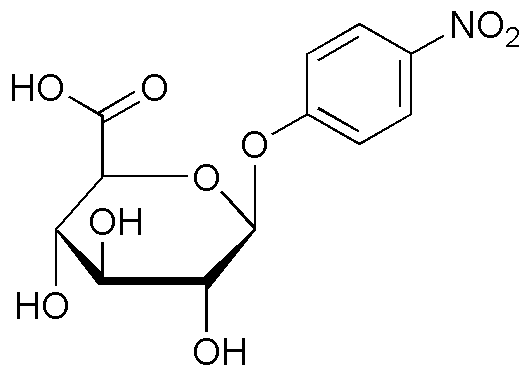4-Nitrophenyl-b-D-glucuronide is widely utilized in research focused on:
- Enzyme Activity Assays: This compound serves as a substrate in assays to measure the activity of glucuronidase enzymes, which are important in drug metabolism studies.
- Drug Development: It is used in pharmacokinetic studies to evaluate how drugs are processed in the body, particularly in understanding conjugation reactions.
- Biochemical Research: Researchers employ it to investigate the mechanisms of glucuronidation, a key metabolic pathway for detoxifying various compounds.
- Clinical Diagnostics: The compound can be utilized in diagnostic tests to assess liver function and the body's ability to process certain medications.
- Environmental Studies: It helps in studying the biodegradation of pharmaceuticals, providing insights into how these substances interact with biological systems in the environment.
General Information
Properties
Safety and Regulations
Applications
4-Nitrophenyl-b-D-glucuronide is widely utilized in research focused on:
- Enzyme Activity Assays: This compound serves as a substrate in assays to measure the activity of glucuronidase enzymes, which are important in drug metabolism studies.
- Drug Development: It is used in pharmacokinetic studies to evaluate how drugs are processed in the body, particularly in understanding conjugation reactions.
- Biochemical Research: Researchers employ it to investigate the mechanisms of glucuronidation, a key metabolic pathway for detoxifying various compounds.
- Clinical Diagnostics: The compound can be utilized in diagnostic tests to assess liver function and the body's ability to process certain medications.
- Environmental Studies: It helps in studying the biodegradation of pharmaceuticals, providing insights into how these substances interact with biological systems in the environment.
Documents
Safety Data Sheets (SDS)
The SDS provides comprehensive safety information on handling, storage, and disposal of the product.
Product Specification (PS)
The PS provides a comprehensive breakdown of the product’s properties, including chemical composition, physical state, purity, and storage requirements. It also details acceptable quality ranges and the product's intended applications.
Certificates of Analysis (COA)
Search for Certificates of Analysis (COA) by entering the products Lot Number. Lot and Batch Numbers can be found on a product’s label following the words ‘Lot’ or ‘Batch’.
Numéro de catalogue
Numéro de lot/série
Certificates Of Origin (COO)
This COO confirms the country where the product was manufactured, and also details the materials and components used in it and whether it is derived from natural, synthetic, or other specific sources. This certificate may be required for customs, trade, and regulatory compliance.
Numéro de catalogue
Numéro de lot/série
Safety Data Sheets (SDS)
The SDS provides comprehensive safety information on handling, storage, and disposal of the product.
DownloadProduct Specification (PS)
The PS provides a comprehensive breakdown of the product’s properties, including chemical composition, physical state, purity, and storage requirements. It also details acceptable quality ranges and the product's intended applications.
DownloadCertificates of Analysis (COA)
Search for Certificates of Analysis (COA) by entering the products Lot Number. Lot and Batch Numbers can be found on a product’s label following the words ‘Lot’ or ‘Batch’.
Numéro de catalogue
Numéro de lot/série
Certificates Of Origin (COO)
This COO confirms the country where the product was manufactured, and also details the materials and components used in it and whether it is derived from natural, synthetic, or other specific sources. This certificate may be required for customs, trade, and regulatory compliance.


